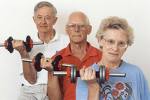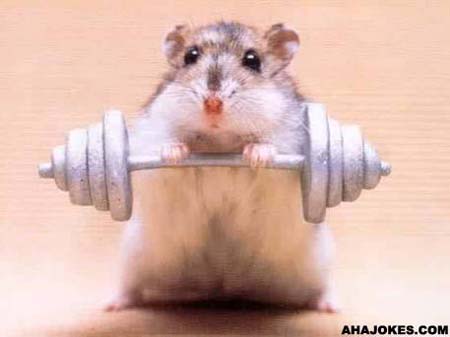March 4, 2008 07:01 - Exercising For The Fun Of It!
"When I catch you, you're in such trouble!!! "
 Researchers at the University of Michigan have discovered that women who exercise regularly and dont stop after a few weeks or a few months are women who are not thinking exclusively about exercising to lose weight.
Researchers at the University of Michigan have discovered that women who exercise regularly and dont stop after a few weeks or a few months are women who are not thinking exclusively about exercising to lose weight. They are thinking that exercise makes them feel good often cheers them up and makes them smile.
They actually have fun.
Long-term participation in an exercise program came from women who enjoyed and took pleasure in their activity. They appreciated the stress relief and the strength they acquired.
Their body shape and the calories they consumed were not their primary motivations.
Source: Michelle Segar, Donna Spruijt-Metz and Susan Nolen-
Hoeksema, "Go Figure? Body-Shape Motives are Associated with
Decreased Physical Activity Participation Among Midlife Women." Sex Roles: A Journal
of Research 54 (3-4): 175-187 (February 2006).
TIP OF THE DAY: Come up with another reason to exercise, besides losing weight. Find a sport or activity that you love to do.
March 5, 2008 07:29 - Forbidden Foods Will Call Out to You
"The older you get, the tougher it is to lose weight because by then, your body and your fat are really good friends!!! "

Researchers in one study placed containers of chocolate kisses in three different locations accessible to individual office workers (in the desk, on the desk, and six feet from the desk), changing the location every few days.
The researchers tracked the number of candies actually eaten each day, and then at the conclusion of the experiment asked participants to estimate how many they had consumed.
They learned two interesting things. First, participants ate 3 candies per day with the container six feet away, 5.7 per day with the candies hidden in their desks, and 8.6 with the candies on their desks (convenient and visible).
Second, participants significantly underestimated how many candies they had eaten from the most inconvenient location.
Source: James E. Painter, Brian Wansink, and Julie B. Hieggelke, "How Visibility and
Convenience Influence Candy Consumption," Appetite 38 (3): 237-238 (June 2002).
TIP OF THE DAY: Keep healthy foods accessible and visible. Dont buy and store unhealthy foods in your home or office, because you may eat more than you intend to.
March 7, 2008 07:23 - Sleeping More Helps You Eat Less
 "Skinny people irritate me! Especially when they say things like, 'You know, sometimes I just forget to eat.' "
"Skinny people irritate me! Especially when they say things like, 'You know, sometimes I just forget to eat.' "
Now I've forgotten my address, my mother's maiden name, and my keys. But I've never forgotten to eat. You have to be a special kind of stupid to forget to eat!"
Scientists at Rockefeller University in New York City discovered the hormone leptin, which is produced by fat cells and passes through the circulatory system to the brain.
Leptin signals the brain and lets it know when food has filled the body. Thus, leptin is an appetite suppressant. Leptin also has some effect on body temperature, so it actually increases the amount of calories burned.
Heres what obesity researchers Jules Hirsch,Jeffrey Friedman, and Rudolph Leibel did: They bred mice that were unable to produce leptin. The result? Those mice all ate nonstop and became obese!
How does this help us humans who want to lose weight?
We need to be sure we are producing enough leptin to let us know when we are satiated. When do humans produce leptin? During sleep and not just the moment we fall asleep, but only after about 6 or seven hours of sleep.
If you are sleep deprived, your supply of leptin may be reduced and you will feel hungry and eat more.
Source: Karine Spiegel, Rachel Leproult, Mireille LHermite-Balériaux, Georges
Copinschi, Plamen D. Penev, and Eve Van Cauter, "Leptin Levels Are Dependent on
Sleep Duration: Relationships with Sympathovagal Balance, Carbohydrate Regulation,
Cortisol, and Thyrotropin." The Journal of Clinical Endocrinology & Metabolism 89:
5762-5771 (November 2004).
TIP OF THE DAY: Get at least seven hours of sleep every night to reduce what you eat.
March 10, 2008 06:35 - To Sum It All Up...
Here's a shameless plug for a program that I believe will help you to follow the advice I have given in my blog posts over the past several weeks.The tips I have given have been proven to work to lose weight and keep it off, but only if you actually USE THEM!

"Sometimes I think I understand everything, then I regain consciousness."
Have you ever struggled to consistently follow your desired eating plan ?. . .
Have you ever failed to overcome intense cravings despite your best efforts ?. . .
Have you ever wished you could find the motivation to get up off the couch and exercise like you know you should ?. .
Most people find that following my list of tips and advice (and adhering to a healthy diet and exercise program overall) is greatly enhanced through the use of hypnotism.
Hypnosis can help you build the eating and exercise patterns of a slim person through concrete, positive suggestions - ways of living based on the scientific behavioral research youve just read.
In the specific program I am referring to, "Enjoying Weight Loss", you will go through seven short hypnosis sessions that last around 20 minutes each. You will only listen to one session a day, so this time commitment is
realistic and attainable.
Each session in the program has a very specific purpose.
Here are their titles:
1. Introduction to Weight Loss
2. Introduction to Hypnosis
3. Selecting Your Food Program
4. Eating Smart
5. Avoiding Temptation
6. Exercising Regularly
7. Appreciating Yourself
8. Maintaining Your Weight Loss
'Enjoying Weight Loss' is produced by a major league weight loss psychologist, Dr. Roberta Temes, who has finally decided to publish the same hypnosis sessions she uses with celebrities and other VIP New York clients. These sessions allow them to follow the advice of their dieticians almost effortlessly, even with their hectic schedules.
Each session will put you into a relaxed state so that both your conscious and subconscious mind are working together to learn as fast and effectively as possible.
This program is recommended by doctors, trainers, and dieticians who us it to help their clients with diet adherence.
This program also comes with an iron-clad 1 YEAR no-questions-asked money-back guarantee, so it will cost you nothing if it doesn't work for you.
You can now save 51% on 'Enjoying Weight Loss' by going here...http://www.hypnosisnetwork.com/hypnosis/weight_loss/special
End of Shameless Plug.
March 11, 2008 07:16 - The Benefits of Strength Training
 Strength training can take you from being a worn out, uncoordinated dependent, to being an active and vital independent individual. It doesn't take a lot of time, and the quality of your life depends on it. Even if you are young and healthy right now, strength training will make everything you do so much easier. (Read Article)
Strength training can take you from being a worn out, uncoordinated dependent, to being an active and vital independent individual. It doesn't take a lot of time, and the quality of your life depends on it. Even if you are young and healthy right now, strength training will make everything you do so much easier. (Read Article)
March 13, 2008 07:18 - Common Myths and Misconceptions About Strength Training
 Strength training and weight lifting exercises have long been the subject of misunderstanding.
Strength training and weight lifting exercises have long been the subject of misunderstanding.Firstly, it is commonly believed that you can exercise a certain part of your body, such as your abs or your butt, and lose the fat in those areas.
This is called spot-reduction, and is a myth. You may well strengthen and build the muscles in the areas you are exercising, but you won't lose fat in that area alone.
Where we store and lose fat is dependent on genetics, hormones and age. If your goal is to reduce fat, then it is best to focus on exercises that will work the whole body, especially the large muscle groups that will burn the maximum calories.
Another misconception is that women should exercise with lighter weights and higher repetitions for maximum toning and fat loss.
The truth is that you should use a variety of weights and repetitions in your workouts.
The weight you use should be sufficient that you can only do the desired number of reps -ie- if you plan to do 10 bicep curls in one set, but could keep going after doing the 10, then you are using too light a weight.
Challenge your body within reason, especially if you are a beginner. Increase the weight gradually as you gain strength to avoid injury and pain. There is nothing that will stop an exercise program quicker than pain.
March 20, 2008 07:13 - Strength Training Principle Number One
 There are 4 main principles to strength training. The first one I want to talk about is 'overload'.
There are 4 main principles to strength training. The first one I want to talk about is 'overload'.What it means is that for you to strengthen your muscles you have to use enough weight to stimulate them.
People most often don't use enough weight to accomplish this.
Muscle plays a huge role in raising your metabolism. A pound of muscle burns about 60 calories a day while a pound of fat burns 5. That means any growth in your muscle tissue is going to help you burn more calories all day long. In fact, strength training has all kinds of great effects on your body like:
- Increases resting metabolic rate so you burn more calories, even while at rest.
- Makes you lean and slim, muscle takes up less space than fat so, the more you have, the slimmer you are
- Strengthening bones and connective tissue, which can protect your body from injuries in daily life
- Enhances balance and stability
- Builds confidence and self-esteem
I mentioned in a previous artcle that if you can do 10 or more repetitions of an exercise and feel like you can still keep going, then you are likely using too little weight for effective muscle growth.
I'm not saying you should jump right to the big bar and slap a hundred pounds on each end and pretend you are Arnold (what he used to be). If you think the weight is too small, add a few pounds and try again until you can only do about 8 reps and just can't do another.
If you like numbers, you should be trying to lift between 70 and 80% of your maximum capability (maximum weight you can lift in one rep) for effective muscle growth and fat loss.
For Beginners:
* Choose a weight you can only lift 16 times. You don't need to go to complete failure, but make sure you're challenging your body.
* Begin with 1 set of each exercise, slowly working your way up to 2-3 sets (i.e., adding a set each week)
* When you've added sets and have a solid foundation (after 6-8 weeks), add more weight so that you can ONLY do 8-12 reps.
* Continue to progress by adding a rep each week until you reach the max reps (no more than 16), increase your weight and drop your reps back down to 8-12.
March 24, 2008 07:15 - Strength Training Principles # 2 and #3
The most important part of any strength training program is starting it. Thinking about starting is where too many people leave off.Once you have started a program, first of all, congratulations, I'm proud of you. Remember though that after about 4 weeks your body will adapt to what you are doing by getting stronger and that to progress you must begin to vary your exercise program.
Variety is the spice of life and is essential to effective strength training.
If you don't vary your program by progressing to heavier weights and different, more challenging exercises, your strength gains and fat loss will stall.
This is the point
March 28, 2008 07:46 - THE GREAT ABS MISTAKE "He Was Doing One Thousand Crunches And Sit Ups A Day... But Still NO Abs!!!
 The following article was written by Tom Venuto of www.BurnTheFat.com fame
The following article was written by Tom Venuto of www.BurnTheFat.com fameIt is a long article so I have broken it into several blog entries to spread it out a bit. It is very informative and Tom says what I have been saying all along about the need to reduce body fat in order to show better muscle definition.
As you can see from his photo above, Tom knows a little about strength training and muscle building...
...After 18 years in the fitness business, How do I get great abs is still BY FAR the most frequently asked question I receive out of the 30,000+ emails that come into my office every month. No doubt, it's because abs are the one body part that most people are the most frustrated with. Although their questions are often phrased differently and each persons situation seems unique, my answer to how do I get great abs is almost always the same
and youre about to hear it...
"1,000 Sit-Ups And Crunches A Day and Still No Abs!"
One question I received recently REALLY got my attention because a young guy told me he was doing 1,000 crunches and sit ups a day and said he still couldnt see his abdominals. He wrote:
Tom: I have been working out for around a year now and I cannot get my lower abs into any type of shape. I'm starting to see my upper abs a little bit, which is great, but despite doing 900 various crunches, ab roller, and 100 sit-ups four days a week, along with my regular workout on the weights, I still have a tire around my waist. What else can I do?
What did I tell him? Well, I gave him the same answer Ive given thousands of people over the years, which is the only true Secret to great abs...
It takes training to increase strength, build endurance and DEVELOP the abdominals, but to SEE the definition in your abdominals - or any other muscle group for that matter - is almost entirely the result of low body fat levels.
This may sound counter-intuitive, but if you can't see your abs, it's not an issue of muscle development at all. You simply have too much body fat covering up the ab muscles. The lower abdominal area also happens to be the one place that most people - especially men - store the body fat first.
There's a Scientific Reason Why Your
Lower Ab Flab Is The Last Place To Go: Belly Fat - A Big Problem
Most people don't have their fat distributed evenly throughout their bodies. Each of us inherits a genetically determined and hormonally-influenced pattern of fat storage just as we inherit our eye or hair color. In other words, the fat seems to "stick" to certain areas more than others.
There's a scientific reason for this. Your fat cells are not just inert "storage tanks" for excess fuel. They are actually endocrine glands which send and receive signals from the rest of the body. You could say that your fat cells "talk to your body" and your body "talks to your fat cells." This occurs through a hormone and receptor system.
For body fat loss to occur, you must first get the fat cell (adipocyte) to release the fat into the bloodstream. THEN, the free fatty acids must be delivered to the working muscles where they are burned for energy.
For fat to be released, the hormone adrenaline (epinephrine) must be secreted and send a signal to your fat cells. Your fat cells receive this hormonal signal via adrenaline receptors called adrenoreceptors.
Fat cells have Beta 1 (B1) and Alpha 2 (A2) receptors. B1 receptors are the good guys. They activate hormone sensitive lipase, the enzyme that breaks down the fat and allows it to be released into the bloodstream to be burned. A2 receptors are the bad guys. They block the fat-releasing enzymes in the fat cell and encourage body fat formation.
Continued in next blog entry...
Visit Tom Venuto's website at www.BurnTheFat.com
March 31, 2008 06:37 - How Body Fat Storage Patterns Affect You
 Here continues the Tom Venuto (www.BurnTheFat.com) article about building a great set of abdominal muscles...
Here continues the Tom Venuto (www.BurnTheFat.com) article about building a great set of abdominal muscles...What's the point of all the physiology? Well, it turns out that in men, the lower abdominal region has a higher concentration of A2 receptors, so this gives us one possible explanation of why the lower abdominal region is often the first place the fat goes when you gain it, and the last place it comes off when you're losing it. (Incidentally, the fat in women's hips and thighs is also higher in A2 receptors). This situation is dictated by genetics and by the hormonal and enzymatic pathways we discussed.
Think of ab fat like the deep end of the swimming pool. No matter how much you protest, there is no way you can drain the deep end before the shallow end. However, don't let this discourage you. Lower ab fat WILL come off, it will simply be the last place to come off. First place on - Last place off.
This helps to explain why abdominal exercises have little impact on body fat loss. It's a huge mistake to think that hundreds or thousands of reps of ab exercises will remove lower abdominal fat, except to the degree that it burns calories and contributes to the calorie deficit. What removes the fat - all over your body - is a calorie deficit and that comes from decreasing food intake, increasing activity, or a combination of both.
What I suggested to this young man was cutting back the ab training, spending the time he was wasting on excess ab exercises for more intense, calorie-burning cardio and weight training for the rest of the body. I also suggested he do an accounting of his food intake, get his nutrition in order and decrease his calories slightly if necessary.
As it turned out, his diet was a mess, and as nutrition experts like to say, "You cant out-train a lousy diet."
It's a monumental error to think that 1,000 reps of ab work a day will make your abs finally "pop" when your diet is a disaster and that's leading to fat storage. Its not that ab exercises arent important. But all the ab exercises in the world won't help as long as you still have body fat covering the muscles. You can't "spot reduce" with abdominal exercise and YOU CAN'T SEE YOUR ABS THROUGH A LAYER OF BODY FAT!




